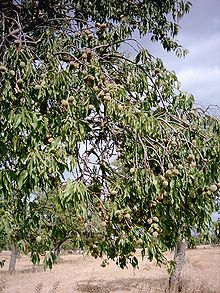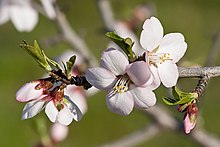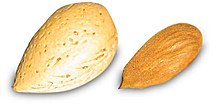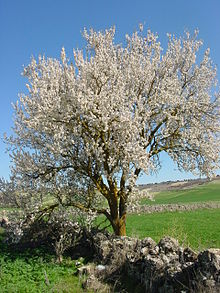Almond: Difference between revisions
move paragraph to more appropriate place |
No edit summary |
||
| Line 19: | Line 19: | ||
{{nutritionalvalue | name=Almond, nut, raw | kJ=2418| protein=22 g | fat=51 g | satfat=4 g | monofat=32 g | polyfat=12 g | carbs=20 g | fibre=12 g | | sugars=5 g | iron_mg=4 | calcium_mg=248 | magnesium_mg=275 | phosphorus_mg=474 | potassium_mg=728 | zinc_mg=3 | vitC_mg=0.0 | pantothenic_mg=0.3 | vitB6_mg=0.13 | folate_ug=29 | thiamin_mg=0.24 | riboflavin_mg=0.8 | niacin_mg=4 | right=1 | source_usda=1 }} |
{{nutritionalvalue | name=Almond, nut, raw | kJ=2418| protein=22 g | fat=51 g | satfat=4 g | monofat=32 g | polyfat=12 g | carbs=20 g | fibre=12 g | | sugars=5 g | iron_mg=4 | calcium_mg=248 | magnesium_mg=275 | phosphorus_mg=474 | potassium_mg=728 | zinc_mg=3 | vitC_mg=0.0 | pantothenic_mg=0.3 | vitB6_mg=0.13 | folate_ug=29 | thiamin_mg=0.24 | riboflavin_mg=0.8 | niacin_mg=4 | right=1 | source_usda=1 }} |
||
The '''Almond''' ('''''Prunus dulcis''''', [[Synonym (taxonomy)#Botany|syn.]] ''Prunus amygdalus'' Batsch., ''Amygdalus communis'' L., ''Amygdalus dulcis'' Mill.) is a species of tree of the genus ''[[Prunus]]'', belonging to the subfamily [[Prunoideae]] of the family [[Rosaceae]]. Within ''Prunus'', it is classified in the subgenus ''Amygdalus'', distinguished from the other subgenera by the corrugated seed shell. |
The '''Almond''' ('''''Prunus dulcis''''', [[Synonym (taxonomy)#Botany|syn.]] ''Prunus amygdalus'' Batsch., ''Amygdalus communis'' L., ''Amygdalus dulcis'' Mill.) is a species of tree of the genus ''[[Prunus]]'', belonging to the subfamily [[Prunoideae]] of the family [[Rosaceae]] and native to the Middle East. Within ''Prunus'', it is classified in the subgenus ''Amygdalus'', distinguished from the other subgenera by the corrugated seed shell. |
||
Almond is also the name of the edible and widely cultivated [[seed]] of this tree. Although popularly referred to as a [[Nut (fruit)|nut]], the almond seed or fruit is botanically not a true nut, but a [[drupe]]. |
Almond is also the name of the edible and widely cultivated [[seed]] of this tree. Although popularly referred to as a [[Nut (fruit)|nut]], the almond seed or fruit is botanically not a true nut, but a [[drupe]]. |
||
Revision as of 14:06, 10 December 2008
This article needs additional citations for verification. (February 2008) |
| Almond | |
|---|---|

| |
| Almond tree with ripening fruit. Majorca, Spain. | |
| Scientific classification | |
| Kingdom: | |
| Division: | |
| Class: | |
| Order: | |
| Family: | |
| Subfamily: | |
| Genus: | |
| Subgenus: | Amygdalus
|
| Species: | P. dulcis
|
| Binomial name | |
| Prunus dulcis (Mill.) D.A.Webb
| |
| Nutritional value per 100 g (3.5 oz) | |||||||||||||||||||||||||||||||||||||||
|---|---|---|---|---|---|---|---|---|---|---|---|---|---|---|---|---|---|---|---|---|---|---|---|---|---|---|---|---|---|---|---|---|---|---|---|---|---|---|---|
| Energy | 2,418 kJ (578 kcal) | ||||||||||||||||||||||||||||||||||||||
20 g | |||||||||||||||||||||||||||||||||||||||
| Sugars | 5 g | ||||||||||||||||||||||||||||||||||||||
| Dietary fibre | 12 g | ||||||||||||||||||||||||||||||||||||||
51 g | |||||||||||||||||||||||||||||||||||||||
| Saturated | 4 g | ||||||||||||||||||||||||||||||||||||||
| Monounsaturated | 32 g | ||||||||||||||||||||||||||||||||||||||
| Polyunsaturated | 12 g | ||||||||||||||||||||||||||||||||||||||
22 g | |||||||||||||||||||||||||||||||||||||||
| |||||||||||||||||||||||||||||||||||||||
| †Percentages estimated using US recommendations for adults,[1] except for potassium, which is estimated based on expert recommendation from the National Academies.[2] | |||||||||||||||||||||||||||||||||||||||
The Almond (Prunus dulcis, syn. Prunus amygdalus Batsch., Amygdalus communis L., Amygdalus dulcis Mill.) is a species of tree of the genus Prunus, belonging to the subfamily Prunoideae of the family Rosaceae and native to the Middle East. Within Prunus, it is classified in the subgenus Amygdalus, distinguished from the other subgenera by the corrugated seed shell.
Almond is also the name of the edible and widely cultivated seed of this tree. Although popularly referred to as a nut, the almond seed or fruit is botanically not a true nut, but a drupe.
Description
The almond is a small deciduous tree, growing to between 4 and 10 meters in height, with a trunk of up to 30 centimeters in diameter. The young shoots are green at first, becoming purplish where exposed to sunlight, then grey in their second year. The leaves are 1 cm long and 1.2–4 cm broad, with a serrated margin and a 2.5 cm petiole. The flowers are white or pale pink, 3–5 cm diameter with five petals, produced singly or in pairs before the leaves in early spring.[3][4]
The fruit is a drupe 3.5–6 cm long, with a downy outer coat. The outer covering or exocarp, (fleshy in other members of Prunus such as the plum and cherry), is instead a leathery grey-green coating called the hull, which contains inside a hard shell, and the edible seed, commonly called a nut in culinary terms. Generally, one seed is present, but occasionally there are two. In botanical terms, an almond is not a true nut. The reticulated hard woody shell (like the outside of a peach pit) surrounding the edible seed is called the endocarp. The fruit is mature in the autumn, 7–8 months after flowering.[3][4]
Origin and history
The almond is native to an area of the Middle East stretching from Pakistan eastwards to Syria and Turkey. It was spread by humans in ancient times along the shores of the Mediterranean into northern Africa and southern Europe and more recently transported to other parts of the world, notably California.[5]
The wild form of domesticated almond grows in parts of the Levant; almonds must first have been taken into cultivation in this region. The fruit of the wild forms contains the glycoside amygdalin, "which becomes transformed into deadly prussic acid (hydrogen cyanide) after crushing, chewing, or any other injury to the seed."[6] Before cultivation and domestication occurred, wild almonds were harvested as food and doubtless were processed by leaching or roasting to remove their toxicity.[citation needed]

However, domesticated almonds are not toxic; Jared Diamond argues that a common genetic mutation causes an absence of glycoside amygdalin, and this mutant was grown by early farmers, "at first unintentionally in the garbage heaps, and later intentionally in their orchards".[7] Zohary and Hopf believe that almonds were one of the earliest domesticated fruit-trees due to "the ability of the grower to raise attractive almonds from seed. Thus, in spite of the fact that this plant does not lend itself to propagation from suckers or from cuttings, it could have been domesticated even before the introduction of grafting".[6] Domesticated almonds appear in the Early Bronze Age (3000–2000 BC) of the Near East, or possibly a little earlier. A well-known archaeological example of the almond is the fruit found in Tutankhamun's tomb in Egypt (c. 1325 BC), probably imported from the Levant.[6] The domesticated form can be found as far north as Iceland[8] although the official distribution of the plant in Europe shows the most northerly country to be Germany.[9]
Etymology and names
The word "almond" comes from Old French almande or alemande, late Latin amandola, derived through a form amingdola from the Greek αμυγδαλη (cf Amygdala), an almond. The al- for a- may be due to a confusion with the Arabic article al, the word having first dropped the a- as in the Italian form mandorla; the British pronunciation ah-mond and the modern Catalan ametlla and modern French amande show a form of the word closer to the original.
The adjective "amygdaloid" (literally "like an almond") is often used for things which are roughly almond-shaped, particularly a shape which is partway between a rectangle and an ellipse.
Almond is called Lawz in Arabic and Baadaam in Hindi, Punjabi, Telugu, Gujarati, Turkish, Urdu, Persian and Kashmiri.
Production


Global production of almonds is around 1.7 million tonnes, with a low of 1 million tonnes in 1995 and a peak of 1.85 million tonnes in 2002 according to Food and Agriculture Organization (FAO) figures.[10] According to the FAO, world production of almonds was 1.76 million tonnes in 2006. Major producers are the USA (715623 t, 41%), Spain (220000 t, 13%), Syria (119648 t, 7%), Italy (112796 t, 6%), Iran (108677 t, 6%) and Morocco (83000 t, 5%). Algeria, Tunisia and Greece each account for 3%, Turkey, Lebanon and China each account for 2%.[11] In Turkey, most of the production comes from the Datca peninsula. In Spain, numerous commercial cultivars of sweet almond are produced, most notably the Jordan almond (imported from Málaga) and the Valencia almond. In the United States, production is concentrated in California, with almonds being California's sixth leading agricultural product and its top agricultural export. California exported almonds valued at 1.08 billion dollars in 2003, about 70% of total California almond crop.

Pollination
The pollination of California's almonds is the largest annual managed pollination event in the world, with close to one million hives (nearly half of all beehives in the USA) being trucked in February to the almond groves. Much of the pollination is managed by pollination brokers, who contract with migratory beekeepers from at least 38 states for the event. Pollination demand is high enough in the Californian Central Valley that bees may be imported from Australia for the February almond bloom.[12]
Diseases
Sweet and bitter almonds

There are two forms of the plant, one (often with white flowers) producing sweet almonds, and the other (often with pink flowers) producing bitter almonds. The kernel of the former contains a fixed oil and emulsion. As late as the early 20th century the oil was used internally in medicine, with the stipulation that it must not be adulterated with that of the bitter almond; it remains fairly popular in alternative medicine, particularly as a carrier oil in aromatherapy, but has fallen out of prescription among doctors.
The bitter almond is rather broader and shorter than the sweet almond, and contains about 50% of the fixed oil which also occurs in sweet almonds. It also contains the enzyme emulsin which, in the presence of water, acts on a soluble glucoside, amygdalin, yielding glucose, cyanide and the essential oil of bitter almonds, which is nearly pure benzaldehyde. Bitter almonds may yield from 4–9mg of hydrogen cyanide per almond.[13][14] Extract of bitter almond was once used medicinally, but even in small doses effects are severe and in larger doses can be deadly; the cyanide must be removed before consumption.[15]
Culinary uses

While the almond is often eaten on its own, raw or toasted, it is also a component of various dishes. It, along with other nuts, is often sprinkled over desserts, particularly sundaes and other ice cream based dishes. Sweet almonds are used in marzipan, nougat, French macaroons, Financiers, baklava and other sweets and desserts. They are also used to make almond butter, a spread similar to peanut butter, popular with peanut allergy sufferers and for its less salty taste. The young, developing fruit of the almond tree can be eaten whole ("green almonds") when they are still green and fleshy on the outside and the inner shell has not yet hardened. The fruit is somewhat sour, and is available only from mid April to mid June; pickling or brining extends the fruit's shelf life. A popular snack in parts of the Middle East, they are eaten dipped in salt to balance the sour taste.
In Greece, ground blanched almonds are used as the base material in a great variety of desserts, usually called amygdalota (αμυγδαλωτά). Because of their white colour, most are traditionally considered "wedding sweets" and are served at wedding banquets.
In China, almonds are used in a popular dessert where they are mixed with milk and then served hot. In Indian cuisine, almonds are the base ingredient for pasanda-style curries. Badam Halva is a very tasty sweet made from almond with some added coloring. Badam flakes are added to many sweets (such as sohan burfy] and are usually visible sticking to the outer surface.

Almonds can be processed into a milk substitute called almond milk; the nut's soft texture, mild flavour, and light colouring (when skinned) make for an efficient analog to dairy, and a soy-free choice, for lactose intolerant people, vegans, and so on. Raw, blanched, and lightly toasted almonds all work well for different production techniques, some of which are very similar to that of soymilk and some of which actually use no heat, resulting in "raw milk" (see raw foodism).
The Marcona variety of almond, which is shorter, rounder, sweeter, and more delicate in texture than other varieties, originated in Spain and is becoming popular in North America and other parts of the world.[16] Marcona almonds are traditionally served after being lightly fried in oil, and are also used by Spanish chefs to prepare a dessert called turrón.
Almond syrup
Historically, almond syrup was an emulsion of sweet and bitter almonds usually made with barley syrup (orgeat syrup) or in a syrup of orange-flower water and sugar.
The Grocer's Encyclopedia (1911) notes that "Ten parts of sweet almonds are generally employed to three parts of bitter almonds"; however, due to the cyanide found in bitter almonds, modern syrups generally consist of only sweet almonds.
Oils
"Oleum Amygdalae", the fixed oil, is prepared from either variety of almond and is a glyceryl oleate, with a slight odour and a nutty taste. It is almost insoluble in alcohol but readily soluble in chloroform or ether. It may be used as a substitute for olive oil.
The sweet almond oil is obtained from the dried kernel of the plant. This oil has been traditionally used by massage therapists to lubricate the skin during a massage session, being considered by many to be an effective emollient. It is a mild, lightweight oil, rich in unsaturated fats and essential fatty acids which is easily absorbed into the skin. Used to make many natural skin care products, it is very high in omega-3. Almond oil is also used as a wood conditioner of certain woodwind instruments such as the oboe and clarinet.
Nutrition and health
The sweet almond itself contains practically no carbohydrates and may therefore be made into flour for cakes and cookies (biscuits) for low-carbohydrate diets or for patients suffering from diabetes mellitus or any other form of glycosuria. Almond flour is gluten-free and therefore a popular ingredient in cookery in place of wheat flour for gluten-sensitive people and people with wheat allergies and coeliac disease. A standard serving of almond flour, 1 cup, contains 20 grams of carbohydrates, of which 10 g is dietary fibre, for a net of 10 g of carbohydrate per cup. This makes almond flour very desirable for use in cake and bread recipes by people on carbohydrate-restricted diets.
Almonds are a rich source of Vitamin E, containing 24 mg per 100 g.[17] They are also rich in monounsaturated fat, one of the two "good" fats responsible for lowering LDL cholesterol.
Claimed health benefits of almonds include improved complexion, improved movement of food through the colon (feces) and the prevention of cancer.[18] Recent research associates the inclusion of almonds in the diet with elevating the blood levels of high density lipoproteins and of lowering the levels of low density lipoproteins.[19][20]
A controlled trial showed that 73g of almonds in the daily diet reduced LDL cholesterol by as much as 9.4%, reduced the LDL:HDL ratio by 12.0%, and increased HDL-cholesterol (i.e., the good cholesterol) by 4.6%.[21]
In Ayurveda, an ancient system of health care that is native to the Indian subcontinent, almond is considered a nutritive for brain and nervous system. It is said to induce high intellectual level and longevity. Almond oil is called Roghan Badam in both Ayurveda and Unani Tibb (the Greco-Persian System of Medicine). It is extracted by cold process and is considered a nutritive aphrodisiac both for massage and internal consumption. Recent studies have shown that the constituents of almond have anti-inflammatory, immunity boosting, and anti-hepatotoxicity effects.[22]
Because of cases of Salmonella traced to almonds in 2001 and 2004, in 2006 the Almond Board of California proposed rules regarding pasteurization of almonds available to the public, and the USDA approved them.[23] Since 1 September 2007, raw almonds have technically not been available in the United States. Controversially, almonds labeled as "raw" are required to be steam pasteurised or chemically treated with propylene oxide. This does not apply to imported almonds.[24]
Cultural aspects


The almond is highly revered in some cultures. In Jammu and Kashmir it is designated as the State tree of Kashmir.[25]
The tree grows in Syria and Israel, old Palestine[26], and is mentioned numerous times in the Bible.
In the Old Testament, the almond was a symbol of watchfulness and promise due to its early flowering, symbolizing God's sudden and rapid punishment of His people; in Jeremiah 1:11-12, for instance. In the Bible the almond is mentioned ten times, beginning with Book of Genesis 43:11, where it is described as "among the best of fruits". In Numbers 17 Levi is chosen from the other tribes of Israel by Aaron's rod, which brought forth almond flowers. According to tradition, the rod of Aaron bore sweet almonds on one side and bitter on the other; if the Israelites followed the Lord, the sweet almonds would be ripe and edible, but if they were to forsake the path of the Lord, the bitter almonds would predominate. The almond blossom supplied a model for the menorah which stood in the Holy Temple, "Three cups, shaped like almond blossoms, were on one branch, with a knob and a flower; and three cups, shaped like almond blossoms, were on the other...on the candlestick itself were four cups, shaped like almond blossoms, with its knobs and flowers" (Exodus 25:33-34; 37:19-20). Similarly, Christian symbolism often uses almond branches as a symbol of the Virgin Birth of Jesus; paintings often include almonds encircling the baby Jesus and as a symbol of Mary. The word "Luz", which appears in Genesis 30:37, is usually translated as "hazel", although it seems to be derived from the Arabic name for almonds (Lawz).
In India, consumption of almonds is believed to be good for the brain, while the Chinese consider it a symbol of enduring sadness and female beauty.
See also
- Almond biscuit
- Almond Joy, a candy bar
- Apricot, a related fruit tree
- Blanching
References
- ^ United States Food and Drug Administration (2024). "Daily Value on the Nutrition and Supplement Facts Labels". FDA. Archived from the original on 2024-03-27. Retrieved 2024-03-28.
- ^ National Academies of Sciences, Engineering, and Medicine; Health and Medicine Division; Food and Nutrition Board; Committee to Review the Dietary Reference Intakes for Sodium and Potassium (2019). Oria, Maria; Harrison, Meghan; Stallings, Virginia A. (eds.). Dietary Reference Intakes for Sodium and Potassium. The National Academies Collection: Reports funded by National Institutes of Health. Washington, DC: National Academies Press (US). ISBN 978-0-309-48834-1. PMID 30844154. Archived from the original on 2024-05-09. Retrieved 2024-06-21.
- ^ a b Rushforth, Keith (1999). Collins wildlife trust guide trees: a photographic guide to the trees of Britain and Europe. London: Harper Collins. ISBN 0-00-220013-9.
- ^ a b Griffiths, Mark D. (1992). The New Royal Horticultural Society dictionary of gardening. London: Macmillan Press. ISBN 0-333-47494-5.
{{cite book}}: Unknown parameter|coauthors=ignored (|author=suggested) (help) - ^ Introduction to Fruit Crops, p. 38, Mark Rieger, 2006
- ^ a b c Zohary, Daniel (2000). Domestication of plants in the old world: the origin and spread of cultivated plants in West Asia, Europe, and the Nile Valley. Oxford University Press. p. 186. ISBN 0-19-850356-3.
{{cite book}}: Unknown parameter|coauthors=ignored (|author=suggested) (help) - ^ Diamond, Jared M. (1997). Guns, germs, and steel: the fates of human societies. New York: W.W. Norton. p. 118. ISBN 0-393-03891-2.
- ^ "Prunus dulcis". Plants for a Future. Retrieved 2008-07-17.
- ^ "Flora Europaea Search Results". Royal Botanic Garden Edinburgh. Retrieved 2008-07-17.
- ^ United States Department of Agriculture
- ^ Food and Agriculture Organization of the United Nations
- ^ Michael Pollan
- ^ Karkocha I (1973). "[Semiquantitative method of hydrogen cyanide and sweet almonds]". Roczniki Państwowego Zakładu Higieny (in Polish). 24 (6): 703–5. PMID 4775628.
{{cite journal}}: Unknown parameter|month=ignored (help) - ^ Shragg TA, Albertson TE, Fisher CJ (1982). "Cyanide poisoning after bitter almond ingestion". West. J. Med. 136 (1): 65–9. PMC 1273391. PMID 7072244.
{{cite journal}}:|access-date=requires|url=(help); Unknown parameter|month=ignored (help)CS1 maint: multiple names: authors list (link) - ^ Cantor, D., Fleischer, J., Green, J., & Israel, D. L. (2006). The Fruit of the Matter. mental floss 5 (4): 12.
- ^ Marcona almonds
- ^ White, G. Vitamin E and Minerals: Nutrition from Nuts. AllAboutVision.com. Retrieved August 20, 2006.
- ^ Davis PA, Iwahashi CK (2001). "Whole almonds and almond fractions reduce aberrant crypt foci in a rat model of colon carcinogenesis". Cancer Lett. 165 (1): 27–33. PMID 11248415. Retrieved 2008-07-17.
{{cite journal}}: Unknown parameter|month=ignored (help) - ^ "Almonds: Cholesterol lowering, heart-healthy snack" (Press release). Porter Novelli. 2002. Retrieved 2008-07-17.
{{cite press release}}: Unknown parameter|month=ignored (help) - ^ Spiller GA, Jenkins DA, Bosello O, Gates JE, Cragen LN, Bruce B (1998). "Nuts and plasma lipids: an almond-based diet lowers LDL-C while preserving HDL-C". J Am Coll Nutr. 17 (3): 285–90. PMID 9627917. Retrieved 2008-07-17.
{{cite journal}}: Unknown parameter|month=ignored (help)CS1 maint: multiple names: authors list (link) - ^ Jenkins DJ, Kendall CW, Marchie A; et al. (2002). "Dose response of almonds on coronary heart disease risk factors: blood lipids, oxidized low-density lipoproteins, lipoprotein(a), homocysteine, and pulmonary nitric oxide: a randomized, controlled, crossover trial". Circulation. 106 (11): 1327–32. PMID 12221048. Retrieved 2008-07-17.
{{cite journal}}: Explicit use of et al. in:|author=(help); Unknown parameter|month=ignored (help)CS1 maint: multiple names: authors list (link) - ^ Puri, Har Sharnjit Singh (2002). "Badam (Prunus amygdalus)". Rasayana: Ayurvedic Herbs for Longevity and Rejuvenation (Traditional Herbal Medicines for Modern Times, 2). Boca Raton: CRC. pp. 59–63. ISBN 0-415-28489-9.
- ^ "Action Plan and Pasteurization" (Press release). Almond Board of California. 2007-03-30. Retrieved 2008-06-18.
{{cite press release}}: Check date values in:|date=(help) - ^ Agricultural Marketing Service (2006-11-08) "Almonds Grown in California: Changes to Incoming Quality Control Requirements" (71 FR -FR-65373 65373, 71 FR -FR-65374 65374, 71 FR -FR-65375 65375 and 71 FR -FR-65376 65376)
- ^ Katzer, Gernot (2005-09-11). "Almond (Prunus dulcis)". Retrieved 2008-07-18.
- ^ Tubeileh A, Bruggeman A, Turkelboom F (2004). Growing Olives and Other Tree Species in Marginal Arid Environments. ICARDA.
{{cite book}}: CS1 maint: multiple names: authors list (link)
